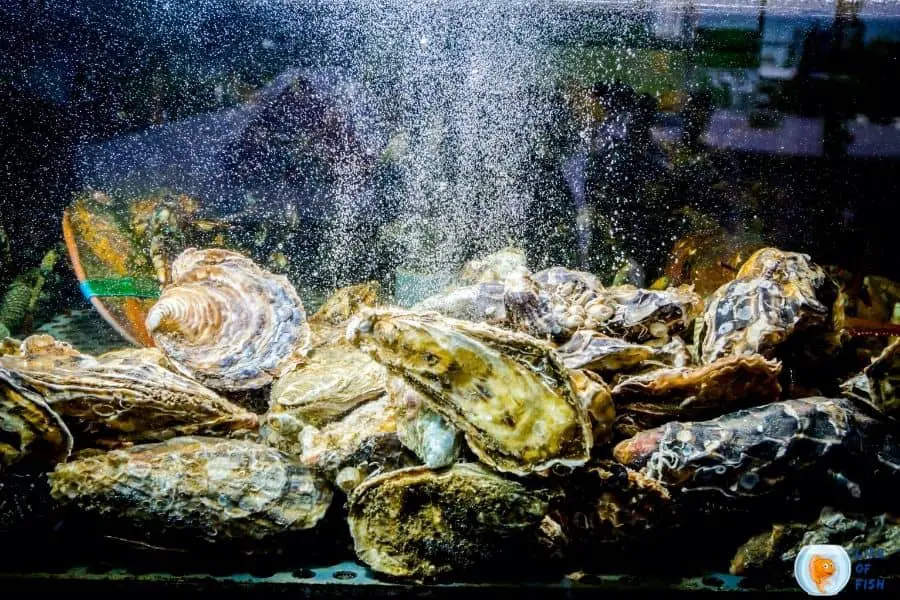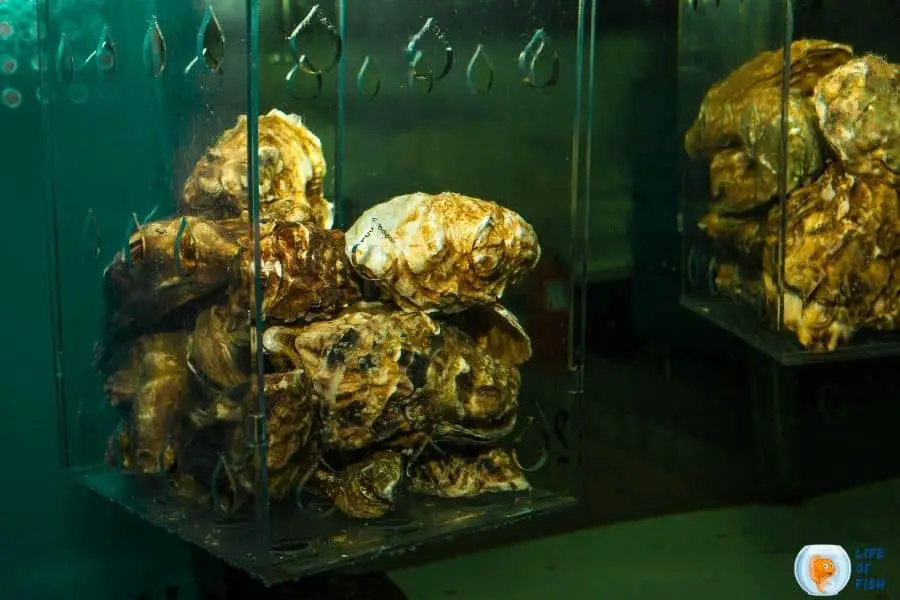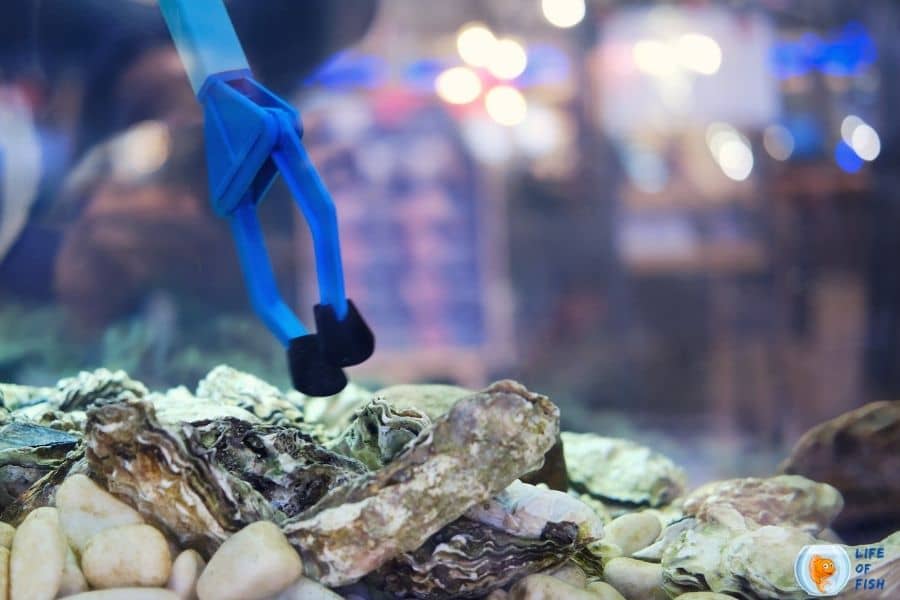Many saltwater aquarists often ask, “Can we raise oysters in an aquarium?” Well, although it is notoriously difficult, we can actually raise oysters in aquariums. You just need some more time and effort.
Oysters are not the usual type of aquarium pet that everyone would keep in their aquarium.
They require constantly refreshing water and special care. But why would anyone want to keep these creatures?
Oysters aren’t the cutest aquarium pets available. But there is more behind them than you might have expected.
This is a detailed guide on how to raise oysters in an aquarium.

Can you raise an oyster in an aquarium?
Jump To
- 1 Can you raise an oyster in an aquarium?
- 2 What are oysters?
- 3 Oyster’s Preferred environmental conditions
- 4 Oysters eat …
- 5 How big do oysters grow?
- 6 How to add an oyster to an aquarium
- 7 Can you use oysters as filters?
- 8 Is it a beginner’s task?
- 9 How long can an oyster survive in a tank?
- 10 Fish go well with oysters
- 11 Do oysters reproduce in a tank?
- 12 Can we raise oysters on an oyster farm?
- 13 Pearls from oysters: Is it possible in a home aquarium?
- 14 Related Question
- 15 Conclusion
Yes. You can raise oysters in an aquarium. However, to grow them successfully, you need to do it the correct way.
One of the most important things is that you need to keep your water conditions stable and give them enough food.
What are oysters?
Oysters are a type of mollusk that comprises about 60 species from both fresh and saltwater.
Their distinctive feature is a single shell that opens into two parts. They mostly live in marine habitats but can also be seen in brackish habitats.
Oysters are popular as a delicacy, and for the pearls, they produce in their mantle.
About five types of oysters are commercially cultivated in many oyster farms for food. Pearl oysters are widely cultured in the eastern and central indo-pacific regions for pearls.
Among them, only a few oyster types can be kept at aquariums.
The species that are kept mainly by aquarists are,
Crassostrea Gigas (Pacific Oysters) – This is an Asian oyster and one of the most common aquarium oysters. It doesn’t need any special conditions, and it does well in an average reef tank. You can feed them with normal meaty food or flakes.
Crassostrea virginicas (Atlantic and Eastern Oysters) – This North American Rock Oyster has more meat than other species, even though it requires slightly different conditions.
Crassostrea ariakensis- Also known as Pacific oyster, Japanese oyster, or Miyagi oyster, it is native to the Pacific coast of Japan and Korea. It doesn’t need special conditions either and can usually be found in aquariums that house other Crassostrea species.
The main problem is that it isn’t easy to find and/or buy these oysters.
Oyster’s Preferred environmental conditions
One of the main reasons oysters are hard to keep in fish tanks is their high nutritional needs.
They are susceptible to changes in water conditions, including temperature, salinity, and hardness. They usually need a stable climate that follows the natural environment of these animals.
The water conditions that should be followed are-
Water temperature– Oysters can tolerate a wide range of temperatures in the wild, from -2C to 36C. However, they prefer temperatures of around 10-30 degrees C (50-86 degrees F) to thrive.
Salinity – Oysters can tolerate a wide range of salinities from 10ppt to 30ppt. They can even survive a short period of time in zero salinity levels.
Their mortality rate, however, increases under high salinity levels. Therefore, Oysters prefer low salinity levels of about 14 to 30ppt.
Hardness– Oysters prefer very soft water, but they can also survive in slightly hard or hard waters.
There are saltwater mixes available to help you with them, but it is hard to provide all their nutritional needs with saltwater mixes.
The best option is giving water directly from the sea, if possible. By constantly providing seawater, you can expect a high survival rate from your oysters.

Oysters eat …
Oysters are filter feeders. They are constantly filtering out plankton from the water.
Although most of their nutrition comes directly from plankton, they can also eat some types of worms, detritus, and mussels.
As mentioned before, it is hard to provide all nutrients oysters need with saltwater mixes. Therefore, you have to feed them with invertebrate food for filter-feeding manually.
You can also supplement the food with fatty-rich, microalgae-filled liquid food used as larval food.
You will have to individually feed each oyster with a pipette or syringe (needle removed) from upstream.
How big do oysters grow?
Oysters can grow up to 20 centimeters (8 inches) wide. However, most types of oysters average around 3 to 5 inches in length.
The largest oyster found was nearly 14 inches long, and it still is growing. According to the Guinness record, it weighed 1.62 kg (3.56 lb).
How to add an oyster to an aquarium
If you are going to add oysters into a fish or reef aquarium, you will have to limit the number to one or two oysters. You can keep more oysters in an oyster-only aquarium.
Oysters require high flow and more food than fish. Most aquarium fish can not tolerate these conditions. Therefore, you can not keep more than two oysters in a fish aquarium.
The below guidelines are for an oyster-only tank.
Before adding an oyster, you should set up the tank to mimic their natural habitats. You will need about a 20-gallon fish tank for about 15 oysters.
Fill the tank with saltwater (preferable seawater) and fill it with an under gravel filter bed.
Install a hang-on-back or canister filter for filtration. To provide high water flow, you can use an aerator and a pump.
For the substrate, you can use either crushed coral, crushed oyster shell, or dolomite.
Before adding any oysters to this aquarium, you should cycle it for about three weeks. This will build up nitrifying bacteria that will help in decomposing waste.
After three weeks, you can put oysters in the aquarium. Add a few at a time and wait about a week before adding some more.
The rule here is you should be careful and handle them gently while adding the oysters.
What are the dangers if you do not provide enough flow?
Oysters can quickly suffocate in low flow areas because they need constant water flow to survive. If too many oysters die in one spot due to lack of water flow, the dead shells will build up and block water flow.
What are the dangers if you choose the wrong type of oyster?
Some types of Oysters do not like shallow water as much as others. If you keep them in such places, they can die because of a lack of dissolved oxygen.
On the other hand, some types develop issues with their shells and become prey.

Can you use oysters as filters?
The answer is not clear for this problem. Although they are filter feeders they do not do well as aquarium filters.
Normally a full-grown oyster can filter about 50 gallons of water per day. But I have seen brown-colored aquariums with oysters.
The reason might be, they do not like to eat fish waste and oysters produce waste of their own.
However, oysters are used as filters in large aquaculture areas with high pollution rates.
I must stress, it is not recommended to use oysters as filters in aquariums. They are challenging to maintain and can not fulfill the nutritional needs of fish or corals in your aquarium.
Is it a beginner’s task?
Growing oysters is definitely not a beginner’s task. They require constant water flow with high nutrition.
Controlling water parameters in a saltwater aquarium requires knowledge and experience. Therefore, raising Oysters in aquariums is not recommended for beginners.
How long can an oyster survive in a tank?
Oysters can usually live up to 20 years in captivity. However, keeping them for more than 2-3 years in an aquarium is not recommended because you can not fulfill all their nutritional needs in an aquarium.
Fish go well with oysters
Most aquarium fish will not bother with oysters around them because they are too small to bother with.
However, some predatory fish like triggers and pufferfish may try to eat them. If you put oysters into a reef tank, you should avoid sea anemones with tentacles similar to the oysters (about 1″).
Also, there is no guarantee that corals will not sting or catch the oysters with their tentacles.
You should avoid any aggressive fish that can nip at the oyster shells or may try to catch them in a chase.
Do oysters reproduce in a tank?
Oysters can not reproduce inside an aquarium because it requires plankton to feed on. This will only be available outside the aquariums where they live in natural seas.
However, you can use another type of mollusk that is smaller in size and place them in your aquarium as food for your oysters.
Can we raise oysters on an oyster farm?
Yes. You can raise oysters in aquaculture farms with no problems. They will grow in aquaculture farms without any special equipment needed to make them grow.
In aquaculture farms, you can provide all their nutritional needs under special care.
They will have natural seawater with the right amounts of water flow and enough feedings from you to thrive. Oysters’ growth rate is higher in aquaculture farms than in aquariums.

Pearls from oysters: Is it possible in a home aquarium?
You can get pearls from oysters if you raise Pinctada oysters in your aquarium. The care needs are the same as for other oysters, but you will have to follow a few extra steps.
You will have to carefully open the shell and put some tiny stones inside the shell. You will have to feed it with oyster roe and clams (preferable smaller oysters).
Allow them to grow for about two years and then open the shells. If you get pearls, you can sell them at a good price because they are rare and valuable.
But, this task requires tremendous skill and precision. One wrong step can kill your oyster right away.
A pearl oyster typically lives for around 3 to 14 years and can produce up to 30 pearls. Oysters are found in the Indian, Pacific, and Atlantic oceans.
Most of these pearls are cultured by people so that they can sell them at a reasonable price. They are also popular as decorative items for home aquariums because of their shiny nature.
What other animal we can use instead of oysters
Other than pearl oysters, any other type of freshwater and saltwater mollusk can form pearls.
But, Pinctada oysters are the most popular because they form more pearls than other mollusks.
Other animals that can produce pearls are pearl mussels, clams, conchs, abalones, conchs, pen shells, whelks, and gastropods.
Pearl oysters are not really edible because their flesh is very thin and soft. However, people may try to catch them in the wild and sell them at local markets because of the high value of pearls that they produce.

Related Question
Can oysters survive in freshwater?
Oysters can survive in fresh water for a short period of time. But they require a salinity between 10 to 30 ppt to live. They can live in brackish waters, but they can not live in freshwater.
How long does it take to grow an oyster?
Oysters take about 18 to 24 months to fully grow into adults and live for about 3 to 14 years maximum.
What do oysters feed on?
Oysters are filter feeders, and they feed on phytoplankton. They obtain their food by filtering the water with their gills.
If they get any undigestable parts while feeding, they expel them as feces and pseudofeces.
So, as you see, they are not detrivores. They eat small parts of algae suspended in the water.
Can I keep an oyster as a pet?
You can oyster as a pet in your aquarium if you know how to provide their environmental conditions.
However, it will be complex than fish keeping, anemones, and other typical saltwater and freshwater pets.
How much does oyster seed cost?
Oysters are sold as seeds in the market and cost about $11 to $20 for 1000 seeds. However, oyster seed suppliers are rare. So, you may not find Oyster seeds from the market easily.
How long can oysters live out of water?
Oysters can live out of water for about 2 to 3 weeks if appropriately kept chilled and moist.
This is primarily done in the food industry because once oysters are dead, they are not safe to eat.
However, these animals die within about an hour or two if you keep them out of the water and do not store them in a refrigerator.
Conclusion
Oysters are incredible animals to keep in an aquarium. However, they are challenging to care for because oysters need refreshing water flow and high nutrition.
They also require a special diet which is hard to provide if you are a novice. Still, raising oysters in an aquarium is not impossible if you are an experienced aquarist.
Read More: Colt Coral | 11 Super Interesting And Fascinating Facts |
